The Araucano people, also known as the Mapuche, are one of the oldest and most resilient indigenous groups in South America. Their rich culture, fierce independence, and profound connection with the land of southern Chile have shaped their identity for centuries. From the vast forests and rivers of the Araucanía region to the Andean foothills, the Mapuche's history is steeped in legends, spirituality, and a deep respect for nature. This story delves into the mythical origins of the Araucano people, exploring the stories of their ancestors, their gods, and the profound sense of unity they shared with the earth. It is a tale of struggle, survival, and the indomitable spirit of a people who refused to be conquered. Long before the first trees reached for the sky and the rivers began to carve their way through the valleys, there was only darkness. According to the Mapuche legends, the world was once an endless sea, devoid of land, light, or life. In the depths of this primordial ocean, the ancient gods, known as Pillán and Ngenechén, resided. Pillán, the god of thunder, controlled the forces of chaos, while Ngenechén, the god of the earth, represented balance and order. One day, Pillán, growing restless in the infinite darkness, decided to create a new world. He summoned the winds to stir the waters, creating massive waves that began to shape the first landmasses. The mountains, rivers, and valleys were born from this tumultuous upheaval. However, this new world was barren, devoid of life. Ngenechén, seeing the emptiness of this creation, decided to bring life to the land. From the earth, he sculpted the first beings—the Mapuche people. He breathed life into them, granting them wisdom, courage, and a deep connection to the natural world. The Mapuche were entrusted with the guardianship of the land, to live in harmony with the rivers, forests, and mountains, and to honor the spirits that resided within them. The world was now complete, and the Mapuche thrived in their new home. They built their villages along the rivers, hunted in the forests, and revered the gods who had given them life. Yet, the harmony of their world would soon be tested. As the Mapuche people flourished in their land, a great shadow began to loom on the horizon. From the distant mountains came a creature unlike any other—a colossal winged serpent known as Cai-Cai Vilú. Cai-Cai was the god of the seas and the master of all water creatures. He had grown envious of the land that Ngenechén had created and sought to reclaim it for the ocean. With a mighty roar that echoed across the mountains, Cai-Cai Vilú unleashed a series of violent storms. Torrential rains fell for days, and the rivers swelled to their breaking points. The seas began to rise, swallowing entire villages and forcing the Mapuche to flee to higher ground. The people cried out to Ngenechén for help, but the god of the earth was silent. Cai-Cai's power seemed unstoppable, and the land was slowly disappearing beneath the waves. In their desperation, the Mapuche turned to an ancient shaman, a wise woman named Machi Guñelén. She was known for her deep connection to the spirits and her ability to communicate with the gods. After days of fasting and prayer, Machi Guñelén received a vision. The only way to save the land from Cai-Cai Vilú was to awaken Tren Tren Vilú, the serpent god of the mountains and protector of the earth. Tren Tren Vilú had been sleeping for centuries, hidden deep within the Andean mountains. According to legend, only a child of pure heart could summon the great serpent from his slumber. The village elders searched for such a child, and their hope was found in a young boy named Llautaro, whose bravery and kindness were known throughout the region. Machi Guñelén led the boy to the sacred mountain, where they performed a ritual to call upon Tren Tren Vilú. The earth trembled as the mountain began to split open, and from its depths emerged the massive serpent. Tren Tren Vilú, his scales gleaming like the sun, rose into the sky to confront Cai-Cai Vilú. What followed was a battle of epic proportions. The two serpents clashed, their roars shaking the very foundations of the earth. Tren Tren Vilú fought to protect the land and its people, while Cai-Cai Vilú sought to reclaim the earth for the sea. The battle raged for days, with neither side willing to yield. As the battle between the two serpent gods continued, the Mapuche people watched in awe and terror. The skies were filled with thunder and lightning, and the ground trembled beneath their feet. The rains continued to pour, and the rivers and seas continued to rise. Many feared that the entire world would be consumed by water. But just when all seemed lost, Tren Tren Vilú gained the upper hand. With a mighty strike of his tail, he sent Cai-Cai Vilú crashing into the sea. The waters began to recede, and the land slowly reemerged from beneath the waves. Tren Tren Vilú had saved the world, but the scars of the battle remained. The landscape of the Araucanía region had been forever changed. New lakes and rivers dotted the land, and entire forests had been swept away by the floodwaters. The Mapuche people, though grateful to Tren Tren Vilú, mourned the loss of their homes and loved ones. But they were a resilient people, and they knew they would rebuild. Machi Guñelén, in her wisdom, told the people that the battle between Tren Tren and Cai-Cai was not over. Though Tren Tren had won the day, Cai-Cai would always seek to reclaim the land for the sea. It was now the responsibility of the Mapuche to live in harmony with both the earth and the sea, to honor the balance between the two forces, and to never forget the power of the gods. With this understanding, the Mapuche began to rebuild their lives. They constructed new villages on higher ground, closer to the mountains where Tren Tren Vilú could protect them. They continued to hunt and gather, but they also developed new ways to live with the ever-present threat of the sea. They learned to respect the rivers and oceans, knowing that they could be both a source of life and a force of destruction. Generations passed, and the Mapuche people grew stronger and more united. They developed a warrior society, known for their bravery and skill in battle. The memory of Tren Tren and Cai-Cai was passed down through the generations, and their story became a symbol of the Mapuche's resilience and strength. As the Mapuche expanded their territory, they encountered other indigenous groups, as well as foreign invaders. The most significant of these invaders were the Spanish, who arrived in the 16th century, seeking to conquer and colonize the land. But the Mapuche were not easily subdued. They had faced gods and monsters, and they would not be intimidated by mere men. The Mapuche warriors, led by legendary leaders like Lautaro and Caupolicán, waged a fierce resistance against the Spanish. They employed guerrilla tactics, using their knowledge of the land to outmaneuver and outlast their enemies. The Spanish, despite their superior weapons and armor, found themselves unable to break the will of the Mapuche. The Mapuche's resistance to Spanish rule became one of the longest and most successful in the history of the Americas. For nearly 300 years, they fought to defend their land and their way of life. Though they faced many hardships, they never surrendered. The spirit of Tren Tren Vilú lived on in their hearts, a reminder that they were the guardians of the earth, and that they would always rise to protect it. Today, the Mapuche people continue to live in the Araucanía region of Chile. Though they have faced centuries of oppression, colonization, and displacement, they have never lost their connection to the land or their sense of identity. The legend of Tren Tren and Cai-Cai remains a central part of their culture, symbolizing the eternal struggle between the forces of nature and the resilience of the human spirit. The Mapuche continue to fight for their rights, their land, and their culture. They honor the legacy of their ancestors, the warriors who fought against the Spanish, and the gods who shaped their world. They remain a proud and independent people, deeply connected to the land that has sustained them for millennia. As the world changes and modernity encroaches on their traditional way of life, the Mapuche hold fast to their beliefs. They continue to practice their rituals, speak their language, and pass down their stories to the next generation. The legend of the Araucano people is not just a story of the past—it is a living, breathing part of their identity, a testament to their strength, their wisdom, and their enduring spirit. In the end, the Mapuche people embody the lessons of their ancient legends. They know that the world is a delicate balance between forces of creation and destruction, between land and sea, between life and death. And like Tren Tren Vilú, they will always rise to protect what is theirs.The Creation of the World
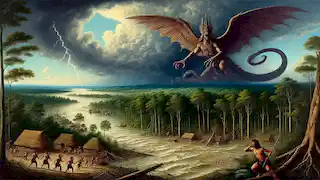
The Arrival of the Winged Serpent
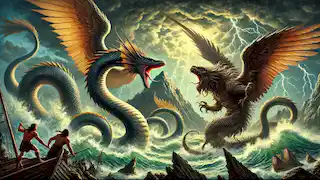
The Great Flood
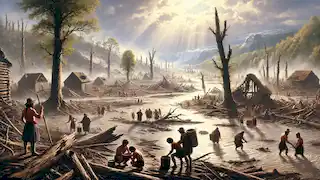
The Rise of the Warriors
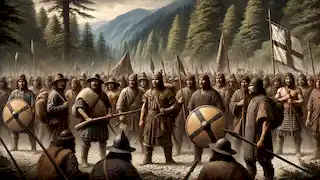
The Legacy of the Araucano People
The Legend of the Araucano People
Reading Time: 8 min
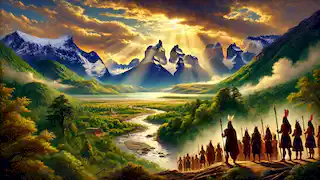
About Story: The Legend of the Araucano People is a Legend Stories from chile set in the Ancient Stories. This Dramatic Stories tale explores themes of Nature Stories and is suitable for All Ages Stories. It offers Cultural Stories insights. A timeless legend of the Mapuche people’s battle between land and sea, gods, and resilience.

















